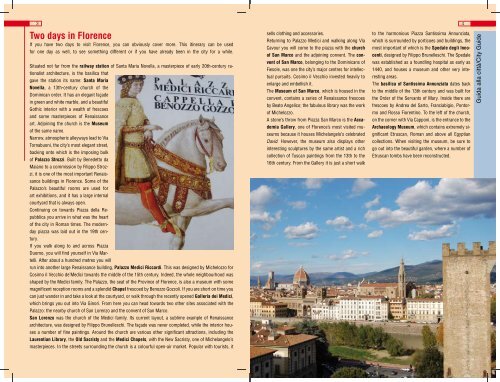You also want an ePaper? Increase the reach of your titles
YUMPU automatically turns print PDFs into web optimized ePapers that Google loves.
3<br />
4<br />
Two days in <strong>Florence</strong><br />
If you have two days to visit <strong>Florence</strong>, you can obviously cover more. This itinerary can be used<br />
for one day as well, to see something different or if you have already been in the city for a while.<br />
Situated not far from the railway station of Santa Maria Novella, a masterpiece of early 20th-century rationalist<br />
architecture, is the basilica that<br />
gave the station its name: Santa Maria<br />
Novella, a 13th-century church of the<br />
Dominican order. It has an elegant façade<br />
in green and white marble, and a beautiful<br />
Gothic interior with a wealth of frescoes<br />
and some masterpieces of Renaissance<br />
art. Adjoining the church is the Museum<br />
of the same name.<br />
Narrow, atmospheric alleyways lead to Via<br />
Tornabuoni, the city’s most elegant street,<br />
backing onto which is the imposing bulk<br />
of Palazzo Strozzi. Built by Benedetto da<br />
Maiano to a commission by Filippo Strozzi,<br />
it is one of the most important Renaissance<br />
buildings in <strong>Florence</strong>. Some of the<br />
Palazzo’s beautiful rooms are used for<br />
art exhibitions, and it has a large internal<br />
courtyard that is always open.<br />
Continuing on towards Piazza della Repubblica<br />
you arrive in what was the heart<br />
of the city in Roman times. The modernday<br />
piazza was laid out in the 19th century.<br />
If you walk along to and across Piazza<br />
Duomo, you will find yourself in Via Martelli.<br />
After about a hundred metres you will<br />
run into another large Renaissance building, Palazzo Medici Riccardi. This was designed by Michelozzo for<br />
Cosimo il Vecchio de’Medici towards the middle of the 15th century. Indeed, the whole neighbourhood was<br />
shaped by the Medici family. The Palazzo, the seat of the Province of <strong>Florence</strong>, is also a museum with some<br />
magnificent reception rooms and a splendid Chapel frescoed by Benozzo Gozzoli. If you are short on time you<br />
can just wander in and take a look at the courtyard, or walk through the recently opened Galleria dei Medici,<br />
which brings you out into Via Ginori. From here you can head towards two other sites associated with the<br />
Palazzo: the nearby church of San Lorenzo and the convent of San Marco.<br />
San Lorenzo was the church of the Medici family. Its current layout, a sublime example of Renaissance<br />
architecture, was designed by Filippo Brunelleschi. The façade was never completed, while the interior houses<br />
a number of fine paintings. Around the church are various other significant attractions, including the<br />
Laurentian Library, the Old Sacristy and the Medici Chapels, with the New Sacristy, one of Michelangelo’s<br />
masterpieces. In the streets surrounding the church is a colourful open-air market. Popular with tourists, it<br />
sells clothing and accessories.<br />
Returning to Palazzo Medici and walking along Via<br />
Cavour you will come to the piazza with the church<br />
of San Marco and the adjoining convent. The convent<br />
of San Marco, belonging to the Dominicans of<br />
Fiesole, was one the city’s major centres for intellectual<br />
pursuits. Cosimo il Vecchio invested heavily to<br />
enlarge and embellish it.<br />
The Museum of San Marco, which is housed in the<br />
convent, contains a series of Renaissance frescoes<br />
by Beato Angelico; the fabulous library was the work<br />
of Michelozzo.<br />
A stone’s throw from Piazza San Marco is the Accademia<br />
Gallery, one of <strong>Florence</strong>’s most visited museums<br />
because it houses Michelangelo’s celebrated<br />
David. However, the museum also displays other<br />
interesting sculptures by the same artist and a rich<br />
collection of Tuscan paintings from the 13th to the<br />
16th century. From the Gallery it is just a short walk<br />
to the harmonious Piazza Santissima Annunziata,<br />
which is surrounded by porticoes and buildings, the<br />
most important of which is the Spedale degli Innocenti,<br />
designed by Filippo Brunelleschi. The Spedale<br />
was established as a foundling hospital as early as<br />
1440, and houses a museum and other very interesting<br />
areas.<br />
The basilica of Santissima Annunziata dates back<br />
to the middle of the 13th century and was built for<br />
the Order of the Servants of Mary. Inside there are<br />
frescoes by Andrea del Sarto, Franciabigio, Pontormo<br />
and Rosso Fiorentino. To the left of the church,<br />
on the corner with Via Capponi, is the entrance to the<br />
Archaeology Museum, which contains extremely significant<br />
Etruscan, Roman and above all Egyptian<br />
collections. When visiting the museum, be sure to<br />
go out into the beautiful garden, where a number of<br />
Etruscan tombs have been reconstructed.<br />
Guida alla città/City <strong>Guide</strong>
















